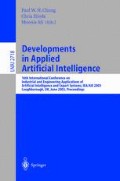Abstract
This study investigated whether two artificial neural networks (ANNs), multilayer perceptron (MLP) and hybrid networks using statistical and ANN approaches, can outperform traditional statistical models for predicting corporate failures in Australia one year prior to the financial distress. The results suggest that hybrid neural networks outperform all other models. Therefore, hybrid neural network model is a very promising tool for failure prediction. This supports the conclusion that for shareholders, policymakers and others interested in early warning systems, hybrid networks would be useful.
Access this chapter
Tax calculation will be finalised at checkout
Purchases are for personal use only
Preview
Unable to display preview. Download preview PDF.
References
Warner, J.B., ‘Bankruptcy costs: some evidence’, The Journal of Finance, 32, 1997, 337–347.
Jinn, T. and J. H. Nam, ‘Bankruptcy Prediction: Evidence from Korean Listed Companies during IMF Crisis’, Journal of International Financial Management and Accounting, 11, 2000, 179–197.
Ohlson, J., ‘Financial ratios and the probabilistic prediction of bankruptcy’, Journal of Accounting Research, 18, 1980, 109–31.
Gentry, J. A., P. Newbold and D. T. Whitford, ‘Classifying bankruptcy firms with funds flow components’, Journal of Accounting Research, 1985, 146–160.
Altman, E., G.E. Pinches, and J.S Trieschmann, ‘Discriminant analysis, classification results and financially distressed property-liability insurers’, Journal of Risk and Insurance, 1977, 289–298.
Deakin, E.B, ‘A discriminant analysis of predictors business failure’, Journal of Accounting Research, Spring, 1972, 167–179.
Blum, M. P., ‘Failing company discriminant analysis’, Journal of Accounting Research, 12, 1974.
Castagna, A.D., and Z.P. Matolcsy, ‘The prediction of corporate failure: testing the Australian experience’, Australian Journal of Management, 1986.
Lincoln, M, ‘An empirical study of the usefulness of accounting ratios to describe levels of insolvency risk’, Journal of Banking and Finance, 7, 1984, 321.
Izan, H, ‘Corporate Distress in Australia’, Journal of Banking and Finance, 8, 1984, 303.
Odom, M. D. and R. Shard, ‘A Neural Network Model for Bankruptcy Prediction’, International Joint Conference on Neural Networks, San Diego, CA, 2, 1990, 163–67.
Coats, P. K and L. F. Fant, ‘Recognizing financial distress patterns using neural network tool’, Financial Management, 22, 1993, 142–155.
Altman E., G. Marco,. and F. Varetto, ‘Corporate distress diagnosis: Comparisons using linear discriminant analysis and neural networks (the Italian experience)’, Journal of Banking and Finance, 18, 1994, 505–529.
Markham, I. and C. Ragsdale, ‘Combining neural networks and statistical predictions to solve the classification problem in discriminant analysis’, Decision Sciences, 26, 1995, 229–241.
Han, I., Y. Kwon, and K. C. Lee, ‘Hybrid neural network models for bankruptcy predictions’, Decision Support Systems, 18, 1996, 63–72.
Rumelhart, D., J. McClelland and PDP Group, Parallel distributed processing. Exploration in the Microstructure of Cognition,.1: Foundation. Cambridge, Mass.: MIT Press, 1986.
Norusis, M. J, ‘SPSS advanced statistics user’s guide’, SPSS, 1990.
Hosmer, D. W. and S. Lemeshow, ‘Applied Logistic Regression’, John Wiley & Sons, 1989.
Author information
Authors and Affiliations
Editor information
Editors and Affiliations
Rights and permissions
Copyright information
© 2003 Springer-Verlag Berlin Heidelberg
About this paper
Cite this paper
Yim, J., Mitchell, H. (2003). A Comparison of Corporate Failure Models in Australia: Hybrid Neural Networks, Logit Models and Discriminant Analysis. In: Chung, P.W.H., Hinde, C., Ali, M. (eds) Developments in Applied Artificial Intelligence. IEA/AIE 2003. Lecture Notes in Computer Science(), vol 2718. Springer, Berlin, Heidelberg. https://doi.org/10.1007/3-540-45034-3_35
Download citation
DOI: https://doi.org/10.1007/3-540-45034-3_35
Published:
Publisher Name: Springer, Berlin, Heidelberg
Print ISBN: 978-3-540-40455-2
Online ISBN: 978-3-540-45034-4
eBook Packages: Springer Book Archive

